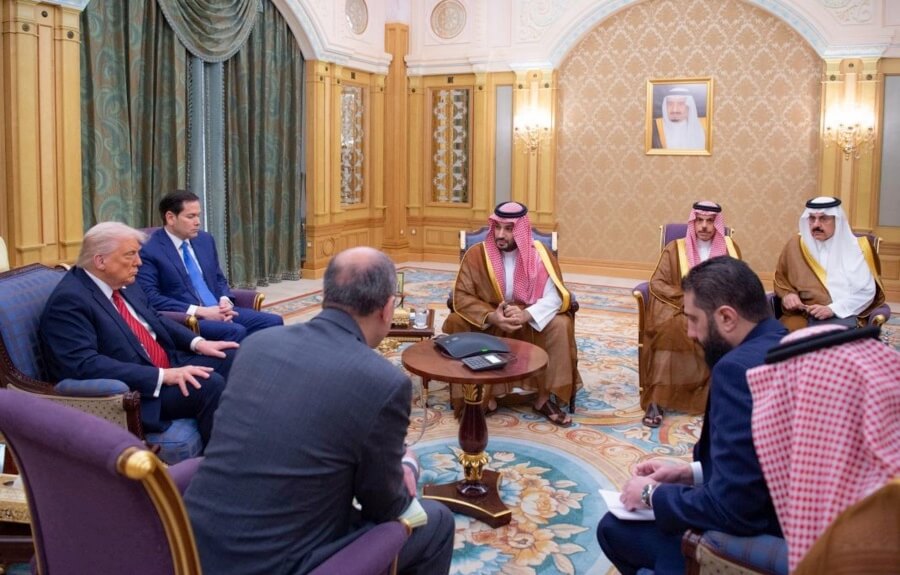U.S. President Donald Trump’s reentry into global diplomacy has reignited both controversy and cautious optimism, as he attempts to reshape the geopolitical landscape through a mixture of economic incentives, strategic alliances, and direct engagement with conflict zones.

His recent high-stakes tour of the Middle East, alongside renewed involvement in South Asia and Indo-Pacific affairs, signals a comprehensive effort to reclaim influence by leveraging trade as the cornerstone of peacebuilding.
Though his approach may lack the polish of traditional diplomacy, the coherence of his strategy –linking regional normalization, economic integration, and pragmatic conflict resolution is undeniable.
Trump’s return to the Middle East comes at a time of profound tension, particularly due to the ongoing Gaza conflict. Against this backdrop, Trump has revived the Abraham Accords initiative, pushing for further normalization between Israel and key Arab states, including Saudi Arabia and Syria.
His bold outreach to Syrian President Ahmed al-Sharaa, proposing a lifting of U.S. sanctions in exchange for alignment with Israeli recognition and counterterrorism cooperation, typifies his transactional, deal-first diplomacy.
While this proposal is unlikely to bear immediate fruit, it underscores Trump’s belief that geopolitical realignment can be incentivized through economic and security guarantees, a belief he has consistently applied across regions.
This economic logic was also evident in Trump’s engagement with Saudi Arabia and the United Arab Emirates, where he negotiated strategic partnerships involving defense cooperation, artificial intelligence infrastructure, and trade. His efforts are not merely about bilateral gains; rather, they are steps toward constructing a transregional arc of stability from the Levant to the Indo-Pacific.
It is within this broader strategic matrix that Trump’s surprise announcement of an Indo-Pakistan ceasefire must be understood. On May 10, 2025, his team successfully brokered what he described as a historic breakthrough between two nuclear-armed rivals locked in one of the world’s longest-standing conflicts.
The agreement came after weeks of backchannel negotiations reportedly facilitated through intermediaries in Doha and Riyadh, with both Indian and Pakistani officials encouraged to embrace a path of economic cooperation over continued militarization.
Trump emphasized that the future of South Asia lies in mutual trade, investment, and infrastructure collaboration, not in maintaining one of the world’s most volatile borders. His approach leaned heavily on economic incentives, offering U.S.-brokered investment guarantees and access to strategic technology partnerships contingent on sustained peace.
Though initial reports of cross-border violations quickly followed the ceasefire declaration, Trump’s administration maintains that these incidents are not systemic breakdowns but rather the “growing pains” of a new diplomatic chapter.
His team is now proposing a trilateral trade and security dialogue involving the U.S., India, and Pakistan to institutionalize the peace framework and prevent backsliding into hostility. This reflects Trump’s broader belief that economics – rather than ideological alignment or moral appeals – should be the bedrock of long-term security arrangements.
By linking peace to prosperity, his team aims to recalibrate the cost-benefit calculation of conflict for both parties. What ties these efforts together is Trump’s belief in peace through prosperity – a belief not grounded in idealism but in a specific kind of realism that sees trade and investment as more effective levers than treaties and institutions.
Whether in Riyadh, New Delhi, or Islamabad, Trump has advanced the notion that modern diplomacy must prioritize economic interdependence as both a deterrent to conflict and a catalyst for regional stability. His emphasis on AI infrastructure in the Gulf, strategic trade agreements in South Asia, and normalization in the Levant forms a mosaic of transactional diplomacy aimed at systemic change.
Yet the risks are real; transactional peace, by nature, can be fragile. It may buy time, encourage dialogue, or even halt fighting temporarily, but without institutional grounding or popular legitimacy, such deals risk unraveling under pressure.
Trump’s approach often sidesteps traditional diplomatic norms and omits crucial human rights considerations, particularly concerning the Palestinian question or Kashmir’s political future. Nonetheless, the momentum he generates – by reframing peace not as a moral imperative but as a shared economic interest forces global actors to reconsider entrenched positions.
Donald Trump’s latest foreign policy maneuvers reveal an interconnected strategy that bridges Middle Eastern normalization, South Asian de-escalation, and Indo-Pacific realignment. While critics may question the sustainability of his methods, the clarity of his vision anchored in strategic coordination, trade facilitation, and pragmatic engagement presents an ambitious attempt to rewrite the rules of diplomacy for a fragmented world order.
In short, whether this vision ultimately delivers durable peace or temporary relief remains to be seen, but its impact on global discourse is already unmistakable. It has reintroduced bold, unconventional diplomacy into mainstream conversation and challenged long-standing diplomatic inertia. In doing so, Trump has forced allies and adversaries alike to reassess the balance between principle and pragmatism in global affairs.
Author: Mirza Abdul Aleem Baig – President of Strategic Science Advisory Council (SSAC) – Pakistan. He is an independent observer of global dynamics, with a deep interest in the intricate working of techno-geopolitics, exploring how science & technology, international relations, foreign policy and strategic alliances shape the emerging world order.
(The views expressed in this article belong only to the author and do not necessarily reflect the editorial policy or views of World Geostrategic Insights).







